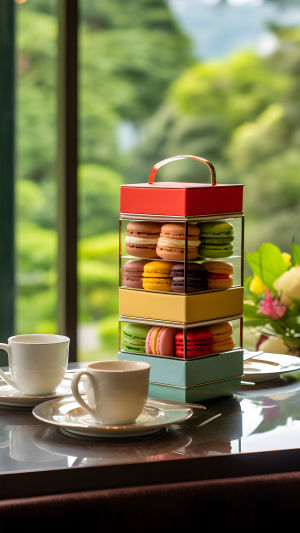Macarons, also known as French macaroons, are a type of French dessert made with egg whites, almond flour, granulated sugar, and icing sugar.
They are filled with fruit jam or cream, boasting a rich texture that's crispy on the outside and soft on the inside. Their appearance is vibrant and colorful, with delicate and intricate designs.
When macarons were first introduced to France, they were quite different from the ones we know today: they were single-layered without any filling. Over time, French chefs began experimenting, especially in the 19th century, gradually transforming them into the sandwiched treats we recognize now.
These imaginative chefs started incorporating various fruits, jams, and even coffee or chocolate to create the diverse colors we see today. Thus, the almond-based cookie evolved into the macarons of the 21st century.
Macarons, which thrived and became renowned in France, are deeply associated with French culture and have become more than just a dessert or food item. They carry a cultural significance.
Historically, macarons were considered a delicacy enjoyed by the nobility, symbolizing luxury.
However, as time passed, they made their way into ordinary households, captivating people, especially women, with their vivid colors, delicate texture, and dainty appearance.
One of the longstanding criticisms of macarons was their sweetness. However, the fillings have evolved to be more refreshing and flavorful.
They no longer possess the cloying sweetness once favored by the older generation in Paris. To counteract the sweetness, the choice of filling is crucial. Bitter coffee, dark chocolate, tangy lemon, or salty caramel can effectively balance the inherent sweetness of macarons. Additionally, pairing them with tea complements their nature as a favored afternoon tea treat in Paris, with options like Ceylon black tea or Darjeeling from India being perfect choices.
Macarons can be a nightmare for baking enthusiasts due to various pitfalls like lack of feet, hollow shells, collapsing, or cracking. Although the process itself isn't exceedingly difficult compared to other baking endeavors, the success rate in achieving perfect macarons is low due to numerous uncontrollable factors—ingredients ratio, equipment, skills, weather, and air humidity—all of which rely heavily on the experience accumulated by pastry chefs.
It's said that even the most renowned pastry chefs cannot guarantee success with every macaron, making it a benchmark product for pastry shops.
Due to their extensive use of matcha, cocoa, fruit jams, or caramel, macarons boast a stunning array of colors.
Eventually, the colors of these treats gained traction in the fashion industry, giving birth to the unique color scheme known as "Macaron colors."
"Macaron colors" are characterized by low saturation. By incorporating 10%-30% of grayscale into pure colors, you achieve these distinctive shades.
The essence of "macaron colors" lies in their "pastel feel." If the base color is bright red, adding some grayscale creates a light pink texture. For green, adding grayscale gives it a delicate pale green color, akin to a sprout.
The core of macaron colors follows a "pink filter," always appearing "soft and pink": pink, baby blue, lavender, mint green, dusty pink, and more.
Macarons, a delightful fusion of history, artistry, and taste, transcend mere confectionery. From noble luxury to everyday delight, these colorful treats have become a symbol of French culture. Their journey reflects culinary evolution and the pursuit of perfection. In their vibrant hues and delicate flavors lies a story that tantalizes both the palate and the imagination, making macarons not just a dessert, but a cherished cultural legacy.





